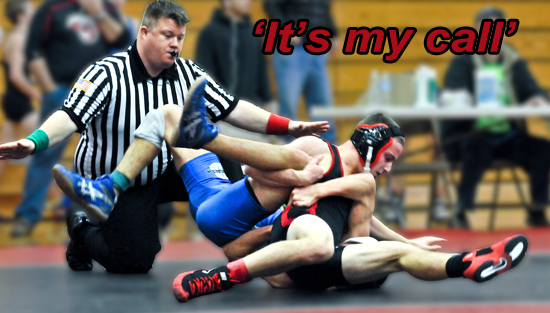Kyle Berger, a former coach and wrestler at North Penn High School, is a PIAA wrestling official who will be contributing bi-weekly columns.
 By Kyle Berger
By Kyle Berger
So you think a wrestling official just shows up, blows the whistle and slaps the mat a few times and leaves?
Not exactly.
During the course of a wrestling season, officials have a laundry list of things to do before, during and after the match. I would argue that a wrestling official’s duties are more involved than any other sports’ officials.
The unique thing about wrestling officials is that typically, we work alone. Much like the wrestlers out on the mat with us, there is no rest, no breaks, nowhere to run and hide.
What follows is a typical schedule of an official for a weeknight dual meet starting at 7:00.
5:30 pm – The official arrives at the host school and checks in with the athletic director or head coach. The official has jurisdiction over the venue as soon as he arrives. That means that if he notices anything illegal (a wrestler trying to cut weight using a rubberized suit or a coach or athlete using tobacco), the official has the right to issue a flagrant misconduct (wrestling-speak for an ejection) on the spot.
6:00 – After changing into the official’s uniform (of which you ALWAYS bring extra shirts/pants/socks), it’s now time to conduct weigh-ins and skin checks. This process can take anywhere from 10 minutes to a half hour. Here is that process:
After making sure that both teams are present and the room is secure, the weigh-in begins. The referee conducts a random draw to determine the starting weight class for both weigh-ins and the dual meet.
Wrestlers are to wear a “suitable undergarment” during weigh-ins – that means boxers/briefs. The reason for this is so that a proper, accurate weight can be determined and so skin, hair, and nail checks can occur.
Prior to stepping on the scale, each wrestler must be inspected for any grooming or skin issues. As an official, you are looking for hair that falls below the eyebrows in front or below where a shirt’s collar would be in back. Also, wrestlers must not have sideburns or beards.
Additionally, each wrestler’s fingernails must be clipped (for obvious reasons).
Skin diseases such as ringworm, MRSA, and impetigo are major concerns in the sport of wrestling, and it’s up to the official to make sure these potential issues are caught.
If a wrestler has a visible skin disease, they are to have a recent note from a doctor indicating that (a) the wrestler is receiving treatment and (b) the disease is no longer contagious.
If a referee suspects a skin disease is present and the wrestler does not have the proper documentation, the referee will not permit them to wrestle.
After the weigh-in is completed, the official signs the weigh-in forms from each team, verifying the weights of each wrestler.
6:30 – After weigh-ins, the official meets with each team and their coaches. During these meetings, the official reads the PIAA sportsmanship message, which lays the groundwork for a respectful competition. Also, the official will usually go over his philosophy on stalling and remind the wrestlers to be properly equipped for competition – that means shoelaces are secured, headgear is worn as the manufacturer intended it to be worn, and there is no jewelry being worn. The official must also check any special equipment (mouth guards for wrestlers with braces, hair covers for those with long hair, etc.). Then there is an opportunity for wrestlers and coaches to ask questions about rules or moves, then the meeting ends.
6:45 – Prior to the start of a dual meet, the official needs to meet with those working at the scorer’s table. These people include the clock operator, public address announcer, and the folks keeping the scorebook for both teams (the home team’s book is the “official” book for the meet). During this time, it should be communicated what the starting weight class will be, if there are any special events (senior night, etc.), and a quick recap of officials’ signals and expectations of the scorers. Also, the official should do a walk-through of the mat area to make sure there is enough space (minimum of 10 feet) between the edge of the mat and the team bench area. Taking some time to do this prior to the dual meet can go a long way in making the evening run smoothly.
7:00 – After the wrestler introductions and National Anthem, the captains of each team meet in the middle of the mat with the official, who flips the red/green disc. The purpose of this is to determine who has choice in each bout. What this means is if the home team wins the toss, they can elect to have choice in the odd or even bouts. If they choose odd, they will have to present a wrestler first at the 1st, 3rd, 5th, and every other odd bout in the dual meet. They will also get choice of position at the beginning of the second period in those bouts. The visiting team would get choice in the even bouts. In many closely contested dual meets, the disc toss is a crucial moment, as it may or may not allow a team to get the matchups they want.
Prior to each bout, the official will make sure each wrestler is properly equipped, make sure the scorer’s table is ready, and begin the match. Repeat this fourteen times, and your night is over.
Technically, the official’s night is truly over when he signs the home team’s scorebook, confirming the team score.
Certainly, there is a lot more to a wrestling official’s duties than one would suspect. In my opinion, the best officials are the ones that are just as good in doing their job prior to 7:00 as they are after.
- Log in to post comments

